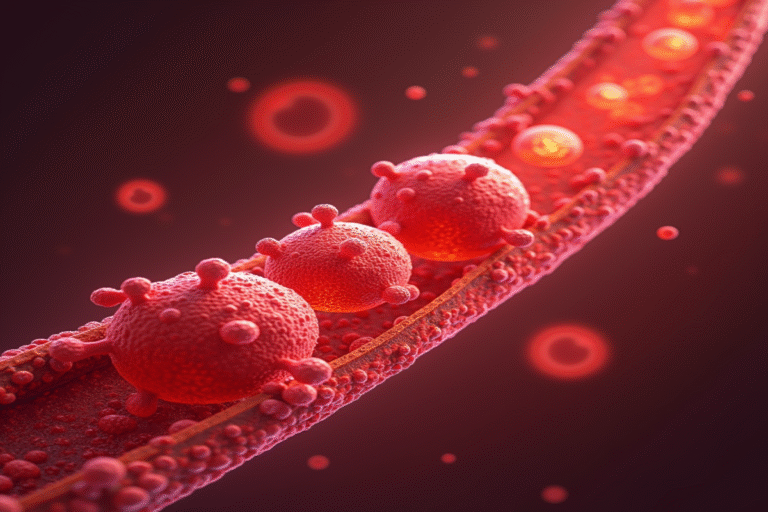Every time you take a breath, you set in motion one of the most elegant chemical processes in your body. Right now, billions of microscopic, iron-containing proteins in your blood are grabbing oxygen molecules from your lungs and delivering them to cells throughout your body. Without this precise biological mechanism, life as we know it would be impossible.
The Iron-Oxygen Bond: A Perfect Chemical Match
At the center of this remarkable process is hemoglobin, the protein that gives your blood its red color. Each hemoglobin molecule contains four heme groups, and at the center of each heme sits a single iron atom. This arrangement is a masterpiece of evolutionary engineering.
The iron atom has a unique electronic structure that allows it to form a temporary but stable bond with oxygen. When blood flows through your lungs, each iron atom acts like a tiny magnet, attracting oxygen molecules that you’ve inhaled. What’s fascinating is that this bond is strong enough to hold oxygen securely, but weak enough to release it when your tissues need it most.
A Numbers Game That Will Blow Your Mind
The scale of this operation is staggering. A single drop of blood contains about 270 million hemoglobin molecules. Each molecule can carry up to four oxygen molecules, meaning one small drop of blood can transport more than a billion oxygen molecules to your cells!
Even more impressive, your body recycles iron with amazing efficiency. When red blood cells die after about 120 days, specialized cells called macrophages recover the iron and send it back to your bone marrow, where it’s used to make new hemoglobin. Nearly 97% of the iron in hemoglobin is recycled in this way.
The Oxygen Journey: From Air to Cell
The journey of an oxygen molecule from the air to your cells is like a perfectly choreographed dance:
- Oxygen enters your lungs when you inhale.
- It passes through the thin walls of your lung’s air sacs (alveoli) into nearby capillaries.
- Inside the blood, the oxygen binds to the iron in hemoglobin.
- Your heart pumps this oxygen-rich blood throughout your body.
- When the blood reaches tissues with low oxygen levels, hemoglobin releases its oxygen cargo.
- The oxygen diffuses into cells, where it’s used to produce energy.
The Color of Life: Why Blood Changes Color
Have you ever wondered why blood appears bright red when oxygenated and darker when deoxygenated? This color change is directly connected to iron. When oxygen binds to iron in hemoglobin, it changes the way the molecule absorbs and reflects light. Oxygen-rich blood reflects more red light, giving it a vibrant scarlet color. When oxygen leaves, the hemoglobin molecule changes shape slightly, absorbing more light and appearing darker—a beautiful visual indicator of its oxygen-carrying status.
When Iron Runs Low: The Domino Effect
Your body contains about 3-4 grams of iron—roughly the weight of a penny—yet this tiny amount is absolutely essential. When iron levels drop too low, your body can’t produce enough working hemoglobin, leading to a condition called iron deficiency anemia.
The symptoms show how crucial this oxygen transport system is: fatigue, weakness, pale skin, shortness of breath, and even difficulty thinking clearly. Your body is essentially experiencing a fuel shortage at the cellular level.
An Ancient Relationship
The partnership between iron and oxygen transport isn’t unique to humans—it’s a solution that evolved over billions of years. Even some bacteria use iron-containing proteins to manage oxygen. This ancient chemical relationship dates back to when Earth’s atmosphere first began to fill with oxygen, making iron one of biology’s oldest and most trusted elements.
Interestingly, some marine animals like octopuses and some arthropods use copper instead of iron to carry oxygen (using hemocyanin instead of hemoglobin), which makes their blood look blue when oxygenated!
The Goldilocks Element
What makes iron so special for this job? It has just the right chemical properties—it can form stable bonds with oxygen that aren’t too strong or too weak. Iron can also switch between different oxidation states, allowing it to bind and release oxygen as needed. Nature tested different metals throughout evolution, but for vertebrates like us, iron proved to be “just right.”
Next time you feel your heart beating or take a deep breath, remember the incredible iron-powered delivery system working tirelessly inside you, connecting the air around you to every living cell in your body. It’s one of nature’s most elegant solutions, happening right now with every heartbeat inside you.





